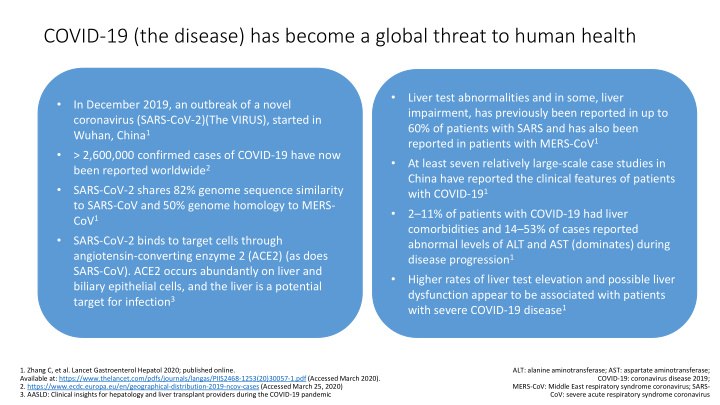



COVID-19 (the disease) has become a global threat to human health • Liver test abnormalities and in some, liver • In December 2019, an outbreak of a novel impairment, has previously been reported in up to coronavirus (SARS-CoV-2)(The VIRUS), started in 60% of patients with SARS and has also been Wuhan, China 1 reported in patients with MERS-CoV 1 • > 2,600,000 confirmed cases of COVID-19 have now • At least seven relatively large-scale case studies in been reported worldwide 2 China have reported the clinical features of patients • SARS-CoV-2 shares 82% genome sequence similarity with COVID-19 1 to SARS-CoV and 50% genome homology to MERS- • 2 – 11% of patients with COVID-19 had liver CoV 1 comorbidities and 14 – 53% of cases reported • SARS-CoV-2 binds to target cells through abnormal levels of ALT and AST (dominates) during angiotensin-converting enzyme 2 (ACE2) (as does disease progression 1 SARS-CoV). ACE2 occurs abundantly on liver and • Higher rates of liver test elevation and possible liver biliary epithelial cells, and the liver is a potential dysfunction appear to be associated with patients target for infection 3 with severe COVID-19 disease 1 1. Zhang C, et al. Lancet Gastroenterol Hepatol 2020; published online. ALT: alanine aminotransferase; AST: aspartate aminotransferase; Available at: https://www.thelancet.com/pdfs/journals/langas/PIIS2468-1253(20)30057-1.pdf (Accessed March 2020). COVID-19: coronavirus disease 2019; 2. https://www.ecdc.europa.eu/en/geographical-distribution-2019-ncov-cases (Accessed March 25, 2020) MERS-CoV: Middle East respiratory syndrome coronavirus; SARS- 3. AASLD: Clinical insights for hepatology and liver transplant providers during the COVID-19 pandemic CoV: severe acute respiratory syndrome coronavirus
Recent Data on studies showing comorbidity with liver disease and liver test change in patients with COVID-19 Patients with Patients with pre- Patients with abnormal liver Notes COVID-19 existing liver tests during disease conditions progression Guan, et al 1 1099 23 (2.3%) AST abnormal (22.2%) Elevated levels of AST were observed in 112 (18.2%) of 615 patients with ALT abnormal (21.3%) non-severe disease and 56 (39.4%) of 142 patients with severe disease. Elevated levels of ALT were observed in 120 (19.8%) of patients with non- severe disease and 38 (28.1%) of 135 patients with severe disease Huang et al 2 41 1 (2.0%) 15 (31.0%) Patients with severe disease had increased incidence of abnormal liver tests. Elevation of AST level was observed in eight (62%) of 13 patients in the ICU compared with seven (25%) 25 patients who did not require care in the ICU Chen, et al 3 99 NA 43 (43.0%) One patient with severe liver function /damage Wang, et al 4 138 4 (2.9%) NA Shi, et al 5 81 7 (.6%) 43 (53.1%) Patients who had a diagnosis of COVID-19 confirmed by CT scan while in the subclinical phase had significantly lower incidence of AST abnormality than did patients diagnosed after the onset of symptoms Xu, et al 6 62 7 (11.0%) 10 (16.1%) Yang, et al 7 52 NA 15 (28.6%) No difference for the incidences of abnormal liver tests between survivors (30%) and non-survivors (28%) Zhang, et al 56 2 (3.6%) 16 (28.6%) One fatal case, with elevated liver tests and liver injury (unpublished) Table from Zhang C, et al. Lancet Gastroenterol Hepatol 2020 1. Guan WJ, et al. N Engl Med 2020; published online Feb 28. 2. Huang C, et al. Lancet 2020;395:497 – 506. 3. Chen N, et al. Lancet 2020;395:507 – 13. 4. Wang D, et al. JAMA 2020;published online Feb 7. 5. Shi H, et al. Lancet Infect Dis 2020; published online Feb 24. 6. Xu XW, et al. BMJ 2020; published online Feb 19. 7. Yang X, et al. Lancet Respir Med 2020; published online Feb 24.
Surveillance of COVID-19 patients with pre-existing liver conditions is required Chronic HBV or HCV 1 Liver Transplant Recipient or Autoimmune Hepatitis 1 Patients with chronic liver disease, especially viral hepatitis B In liver transplant recipients or patients with autoimmune and/or C, may be more susceptible to liver damage from SARS- hepatitis on immunosuppressive therapy, acute cellular CoV-2, as was the case with SARS-CoV, but supporting data are rejection or disease flare, respectively, should not be lacking. presumed in the face of active COVID-19. Decompensated Cirrhosis or those awaiting Liver Primary Biliary Cirrhosis or Primary Sclerosing Cholangitis 1 Transplantation 1 It is unknown whether SARS-CoV-2 infection exacerbates There are currently no clear data on the effects of SARS-CoV-2 cholestasis in those with underlying cholestatic liver disease infection in patients with decompensated cirrhosis or those such as PBC or PSC or with underlying cirrhosis. awaiting liver transplantation. Additional considerations 2 • Liver inflammation in mild cases of COVID-19 is often transient and may return to normal without any special treatment. Liver protective drugs have usually been administered in Chinese patients when severe liver damage occurs • Immune-mediated inflammation, such as cytokine storm and pneumonia-associated hypoxia, may also contribute to liver injury or develop into liver failure in critically ill COVID-19 patients • Concomitant drug therapies may also result in hepatotoxicities, which may explain some of the variation across cohorts 1. AASLD: Clinical insights for hepatology and liver transplant providers during the COVID-19 pandemic 2. Zhang C, et al. Lancet Gastroenterol Hepatol 2020; published online. GGT: gamma-glutamyl transferase; HCC: hepatocellular carcinoma; NAs: Available at: https://www.thelancet.com/pdfs/journals/langas/PIIS2468-1253(20)30057-1.pdf (Accessed March 2020) nucleos(t)ide analogues
Flow chart for the prioritization of patient care in patients with chronic liver disease . The individual management of these patients strongly depends on the local COVID-19 burden and officially implemented rules and regulations. In some countries and areas, maintenance of standard care might not be able and transplantation activities might be reduced. COVID-19, coronavirus disease 2019; HCC, hepatocellular carcinoma; NAFLD, non-alcoholic fatty liver disease; NASH, non- alcoholic steatohepatitis; SARS- CoV-2, severe acute respiratory syndrome coronavirus 2.
AASLD: COVID and the Liver
Recommend
More recommend